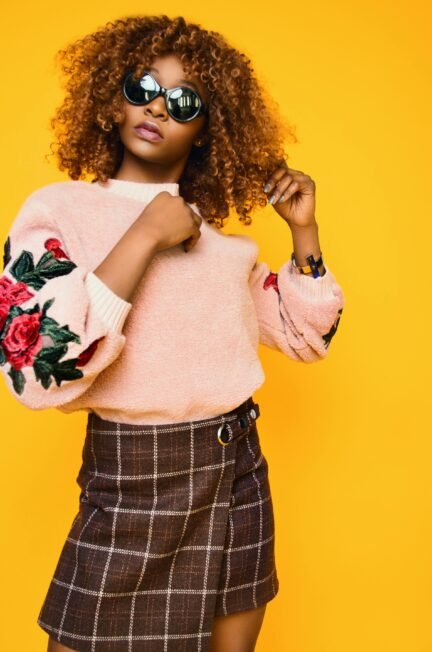Introduction
The rapidly developing industry of fashion plays an important role in molding both cultural identity and personal identity. Underneath the bright lights of major fashion hubs, the unique many-performances reveal a longstanding evolution in our use of dress and jewelry to communicate. With a change in consumer tastes, the trends, materials, and technologies that fuel this dynamic world also change. In this work, we will analyze vital fashion trends, the impact technology has on current fashion, and the rising importance of sustainability.

The Changing Nature of Fashion Trends.
Periodically, trends have resembled the societal and cultural changes that took place in their own times. The wealth of apparel from the Renaissance in conjunction with the bold clothing choices of the 1990s suggest that what people wear carries much greater significance than first impressions. At this time, an increased number of factors, which include international travel, social media, and the growth of influencers, are having an effect on fashion trends. Fashion has ended its existence as a high-end designer perk; it has instead evolved into a global opportunity driven by both mass purchases and digital participation.
For many decades, trendsetting styles have flowed from the top designers and elite houses to the normal population. Recently, this has turned around. Formerly seen as a subculture, streetwear has advanced to become a key trend in mainstream fashion, affecting designs from major designers as well as everyday labels. The high fashion trend that defines luxury as being comfortable, along with big hoodies, sneakers, and graphic tees, makes it seem less unattainable.
Moreover, no longer seasonal. Consumers find it easier than ever to access the newest fashion trends every single year thanks to fast fashion and online shopping. This acceleration of the trend cycle, caused by this method, has led to styles emerging and disappearing in a few short months instead of over years. Despite the allure and thrill produced in this environment, those factors also exacerbate the waste situation since consumers quickly throw away their clothing after they’ve bought it.
The Consequences of Technology for the Fashion Landscape.
Credit technological influence for a wonderful change in all elements of the fashion industry, including the way clothing is produced and the relationships of consumers with brands. The escalation of e-commerce constitutes one of the largest shifts. Online shopping gives people access to worldwide brands, thereby raising the availability of fashion globally.
The function of social media sites, notably Instagram and TikTok, has been exceptionally important. These days, it’s the influencers of fashion and celebrities who are pivotal to the formation and marketing of trends and brands. In the current landscape, sponsored content, fashion hauls, and viral challenges are pioneering methods of marketing in the fashion sector, allowing engagement to happen at the click of a button, and trends to go global in just a few days.
Artificial intelligence (AI) along with machine learning have entered into the fashion market. Combining these technologies supports the personalization of shopping experiences, allows for the study of shopper inclinations, and predicts future trends. Virtual styling platforms powered by AI and chatbots have both boosted online buying experiences and supplied customers with individualized suggestions in a more engaging and interactive atmosphere.
The industry is abuzz with an emerging technology known as virtual reality (VR) and augmented reality (AR). These solutions enable consumers to ‘try on’ clothing or accessories online before they actually buy them. As AR fitting rooms appear more regularly on e-commerce sites, return rates are declining and customer happiness is on the rise. As interest in virtual fashion shows increases, brands discover they can draw a larger audience without the hurdles common to traditional runway shows. Sustainability: An essential element in current fashion.
As understanding of environmental topics deepens, sustainability has risen to become a prime theme in the world of fashion. Since rapid manufacturing at affordable prices negatively influences the environment, the framework of fast fashion has faced backlash. Thanks to excessive waste and the pollution generated from textile manufacturing, there is a huge ecological footprint in the fashion sector. In answer to this, a variety of brands is moving towards more sustainable strategies.
In response to their growing popularity as sustainable textiles, fashion collections are beginning to include organic cotton, bamboo, and recycled polyester. Businesses are also making moves to lessen waste by probing into alternative production opportunities, which involve 3D printing as well as the idea of upcycling. The sustainable practices noted are environmentally beneficial and also finding favor with consumers who are more and more inclined to make moral choices in what they buy.
An emerging trend of vintage and second-hand styles exemplifies the way sustainability is changing the industry landscape. The Thrifting space has turned into a fashionable and environmentally aware avenue to shop, with Depop, Poshmark, and Vestiaire Collective leading the way. Online marketplaces that enable buying and selling of used items lengthen the life of clothes and reduce the call for modern manufacturing.
The idea of circular fashion is one that is on the rise in popularity. The emphasis is on developing clothing with the aim of planning for its end of life, advocating for recycling, transforming or biodegrading it. A range of brands has begun take-back initiatives to motivate their customers to submit their used garments for either recycling or upcycling.
Sustainability: An essential element in current fashion.
As understanding of environmental topics deepens, sustainability has risen to become a prime theme in the world of fashion. Since rapid manufacturing at affordable prices negatively influences the environment, the framework of fast fashion has faced backlash. Thanks to excessive waste and the pollution generated from textile manufacturing, there is a huge ecological footprint in the fashion sector. In answer to this, a variety of brands is moving towards more sustainable strategies.
In response to their growing popularity as sustainable textiles, fashion collections are beginning to include organic cotton, bamboo, and recycled polyester. Businesses are also making moves to lessen waste by probing into alternative production opportunities, which involve 3D printing as well as the idea of upcycling. The sustainable practices noted are environmentally beneficial and also finding favor with consumers who are more and more inclined to make moral choices in what they buy.
An emerging trend of vintage and second-hand styles exemplifies the way sustainability is changing the industry landscape. The Thrifting space has turned into a fashionable and environmentally aware avenue to shop, with Depop, Poshmark, and Vestiaire Collective leading the way. Online marketplaces that enable buying and selling of used items lengthen the life of clothes and reduce the call for modern manufacturing.
Virtual fashion is one of the emerging trends coming soon. Articles of clothing just in the digital realm, produced with no physical labor, might help to reduce environmental damage. Hosting virtual catwalk shows along with developing relationships with influencers might help grow this future-oriented trend, prompting consumers to buy garments not for wearing in the physical world, but for their online avatars.
Going ahead, we can expect that fashion will play an important role as a way to articulate oneself and interpret the subtleties of culture. During industry growth, it will reflect the changing preferences and requirements of society, leading to plenty of opportunities for both creativity and innovation.
Conclusion
Fashion represents much more than the items of clothing we attribute to it. It highlights our principles, identity, and also our dreams. The industry goes through development, supported by trends, technology, and the choices of consumers. The integration of contemporary technology, sustainability, or inclusivity will not prevent fashion from having a strong effect on transforming our environment in interesting and influential ways. Navigating the future of fashion successfully requires that both fans of fashion and industry influencers stay informed about these developments.

